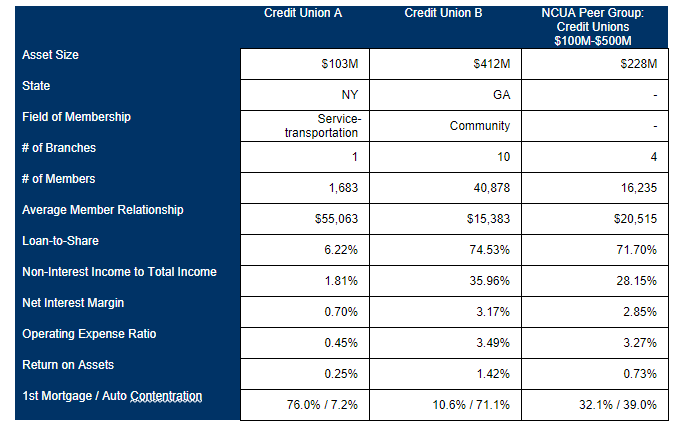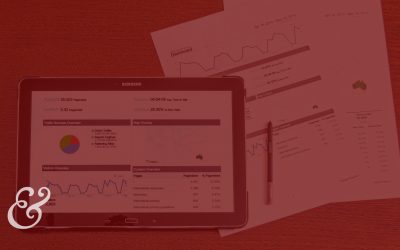While benchmarking your performance against asset-based peer groups has value, relying strictly on asset size for peer group analysis can skew your benchmarks by including credit unions that don’t share much in common with your institution.
Just take a look at this actual example of two credit unions within the same NCUA-designated peer group:

*Data as of December 31st, 2022
As the table shows, these credit unions are not an ideal comparison for each other, despite their similarities. For more accurate benchmarks against which to measure your credit union’s performance, try using the criteria below in addition to asset size.
Three Peer Group Ideas That Go Beyond Asset Size
Local:
This peer group is comprised of credit unions around your asset size and located within your local market. These are your closest real competitors for the same membership. While differences in chartered fields of membership must always be considered, there are certainly unique economic and cultural characteristics that affect various regions of the country in different ways. A local peer group helps control your comparison based on these factors.
Request A Free Local Scorecard
Business Model:
This peer group is comprised of credit unions that are similar to you in a key aspect(s) of your current business model.
These are the credit unions most like you today, based on the way you operate. For this peer group, we generally recommend expanding the geographic range to broaden the net of available peers.
Sample Metrics For Your Business-Model Peer Group:
- Loan portfolio breakdowns.
- Reliance on non-interest income.
- Branch footprint.
- Single-SEG fields of membership.
Although these peer groups are similar, the insights really come from how you differ from the group. You may have a similar loan portfolio, but your earnings are dramatically less. What insights come out of that? What are your peers doing differently to spur earnings? Because no two credit unions have exactly the same business model, no peer group will ever be exactly the same as you.
Pro Tip: Pick just a few key filters first and isolate the differences.
Request A Free Business Model Scorecard
Aspirational:
These credit unions are doing something you know you want your credit union to do, but you’re not quite there yet.
An example of this might be a credit union that wants to launch its first credit card product. An aspirational peer group would include a few credit unions that have recently launched a credit card program, allowing you to see how the larger business was impacted by this change.
Other examples of aspirational peer groups include credit unions with above-average loan growth or ROA, or those that have recently completed a merger.
These peer groups can help you learn lessons from your peers, allowing you to set appropriate goals and expectations for the coming years.
Request A Free Aspirational Scorecard
Benchmark Your Credit Union’s Performance
Callahan’s data and the analytics tools within the Peer Suite make it easy to build custom peer groups using the data and strategies listed above and more. With hundreds of built-in formulas, graphs, and tables it’s easy to compare your credit union directly to relevant credit unions and banks.
Callahan clients can log in to the Callahan Portal to access these tools.
Don’t have access? Click here to request a custom scorecard and we’ll show you how easy it is to build comparisons in Peer.
More Blogs
Most Downloaded Policy Exchange Documents Of 2020
There are more than 600 documents in Callahan’s Policy Exchange. Here are the top 10 most downloaded of 2020.
The Guide To A Purpose-Driven Organization
Download The Guide To A Purpose-Driven Organization and learn three steps credit unions can take to start the discussion of purpose at their organization.
10 Chart-Topping Credit Unions in Member Value
In honor of International Credit Union Day, Callahan spotlights credit unions of all sizes that return the most value to members.
How To Leverage Data For Better Strategic Planning
Incorporating peer analysis is an ideal way to enhance the impact of planning for credit unions.
Leading With Purpose
Leading With Purpose is a tool to help credit unions realize the competitive advantages of being purpose-driven.
Fall Virtual Roundtables Are Here!
Explore our upcoming Virtual Roundtables for credit union executives and learn how to register and get involved.
Trends And Takeaways From 2Q20 Trendwatch
With second quarter data now available in Peer-to-Peer, COVID-19’s impact on industrywide metrics is more apparent.
Peer-to-Peer Updates And Enhancements
The COVID-19 crisis has had a sudden and significant impact on the industry’s bottom line and day-to-day operations.
5 Benchmarking Pitfalls To Avoid
Flaws in benchmarking can lead to inaccurate perceptions of your credit union’s performance.










